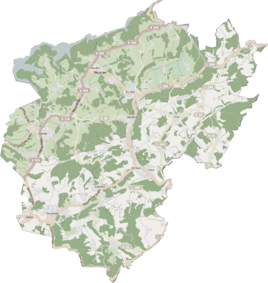Hommermühle
|
Hommermühle
Kurten municipality
Coordinates: 51 ° 3 ′ 5 ″ N , 7 ° 15 ′ 11 ″ E
|
||
|---|---|---|
| Postal code : | 51515 | |
|
Location of Hommermühle in Kürten |
||
Hommermühle is a residential area in the municipality of Kürten in the Rheinisch-Bergisches Kreis .
Location and description
The place lies west of Kürten at the confluence of the Kalsbach in the Hommerbach , a tributary of the Kürtener Sülz . The nature reserve Kalsbachtal (GL-013) is located near the village
history
The Topographia Ducatus Montani by Erich Philipp Ploennies from 1715, Blatt Amt Steinbach , proves that the place already existed as a mill in 1715 and was called Humemühle . From the chart of the Duchy of Berg in 1789 by Carl Friedrich von Wiebeking , it can be seen that Hommermühle was part of the Breibach community in the parish of Kürten in the district court of Kürten at that time .
Under French administration between 1806 and 1813, the Steinbach office was dissolved and Hommermühle was politically assigned to the Mairie Kürten in the canton of Wipperfürth in the Elberfeld arrondissement . In 1816 the Prussians converted the Mairie to the mayor's office in Kürten in the Wipperfürth district . At that time Hommermühle belonged to the village and later municipality of Bechen.
The place is recorded on the topographical survey of the Rhineland from 1824 as a lobster mill and on the Prussian first survey of 1840 as Hommer mill . From the Prussian new entry in 1892, it is regularly recorded on measuring table sheets as Hommer-Mühle or Hommermühle .
In 1830 the place had 18 inhabitants and was called Hommermühl . The place, which was categorized as a courtyard and fruit mill according to the overview of the government district of Cologne in 1845 , had two houses at the time. At that time, 17 inhabitants lived in the place called Hommermühle, all of them of Catholic faith. The municipality and estate district statistics of the Rhine province list Hommermühle 1871 with three houses and 20 inhabitants. In the municipality lexicon for the Rhineland province from 1888, two houses with 14 inhabitants are given. In 1895 the place had two houses and 13 residents. In 1905 the place had two houses and ten residents and belonged denominationally to the Catholic parish of Bechen.
In 1927 the mayor's office in Kürten was transferred to the office of Kürten. In the Weimar Republic in 1929 the offices of Kürten were merged with the municipalities of Kürten and Bechen and Olpe with the municipalities of Olpe and Wipperfeld to form the office of Kürten. The Wipperfürth district became part of the Rheinisch-Bergisch district on October 1, 1932, with its seat in Bergisch Gladbach .
In 1975 the current municipality of Kürten was established on the basis of the Cologne Act , to which, in addition to the offices of Kürten, Bechen and Olpe, a sub-area of the city of Bensberg with Dürscheid and the surrounding areas was added.
The Hommermühle
Only the mill building and millstones in the village bear witness to the watermill that gives it its name . Originally it was a bone mill . Later it was also used as a flour mill. The house is entered in the list of architectural monuments in Kürten .
Individual evidence
- ^ Wilhelm Fabricius : Explanations for the Historical Atlas of the Rhine Province. Second volume: The map from 1789. Division and development of the territories from 1600 to 1794. Bonn 1898.
- ↑ JC Dänzer: Décret impérial sur la circonscription territoriale du grand-duché de Berg… Imperial decree on the division of the Grand Duchy of Berg . 1808, urn : nbn: de: hbz: 061: 1-84858 .
- ↑ a b History of the municipality of Kürten
- ↑ Friedrich von Restorff : Topographical-statistical description of the Royal Prussian Rhine Province , Nicolai, Berlin and Stettin 1830
- ↑ Overview of the components and list of all the localities and individually named properties of the government district of Cologne: by districts, mayor's offices and parishes, with information on the number of people and the residential buildings, as well as the Confessions, Jurisdictions, Military and former state conditions. / ed. from the Royal Government of Cologne [Cologne], [1845]
- ↑ Royal Statistical Bureau Prussia (ed.): The communities and manor districts of the Prussian state and their population . The Rhine Province, No. XI . Berlin 1874.
- ↑ Königliches Statistisches Bureau (Prussia) (Ed.): Community encyclopedia for the Rhineland Province, based on the materials of the census of December 1, 1885 and other official sources, (Community encyclopedia for the Kingdom of Prussia, Volume XII), Berlin 1888.
- ↑ Königliches Statistisches Bureau (Prussia) (Ed.): Community encyclopedia for the Rhineland Province, based on the materials of the census of December 1, 1895 and other official sources, (Community encyclopedia for the Kingdom of Prussia, Volume XII), Berlin 1897.
- ↑ Royal Statistical Bureau (Prussia) (Ed.): Community encyclopedia for the Rhineland Province, based on the materials of the census of December 1, 1905 and other official sources, (Community encyclopedia for the Kingdom of Prussia, Volume XII), Berlin 1909
- ^ GV. NRW. 1974 p. 1072
- ^ Herbert Nicke : Bergische mills. On the trail of the use of hydropower in the land of a thousand mills between Wupper and Sieg . Galunder, Wiehl 1998, ISBN 3-931251-36-5 , pp. 270 .
- ↑ Hommermühle near Kürten | Object view. Retrieved April 27, 2020 .
